Welcome to the Nanopore Community
Order MinION devices and consumables
Visit vwr.comRapid sequencing V14 - Amplicon sequencing (SQK-RBK114.24 or SQK-RBK114.96)
Version for device: MinION
Introduction to the protocol
Overview of the protocol
Overview of the protocol
-
Introduction to amplicon sequencing using the Rapid Barcoding Kit 24 or 96 V14
This protocol describes how to carry out rapid barcoding of amplicon DNA using the Rapid Barcoding Kit 24 or 96 V14 (SQK-RBK114.24 or SQK-RBK114.96) to sequence up to 96 single amplicon samples. This method allows you to perform your own amplicon sequencing and validation with a quick turn-around time, without the need for primers and a reference, and with competitive price per sample. Using this method, PCR amplicons ranging from 500 bp to 5 kb can be sequenced, which allows users to check that each amplicon is the correct size and no mutations have been introduced during PCR amplification.
The analysis workflow is not intended for marker gene sequencing of mixtures/communities of different organisms (e.g. 16S sequencing). In de-novo consensus mode it expects a single amplicon per barcode. When running in variant calling mode, multiple amplicons per barcode can be processed, but their sequences need to be sufficiently different from each other so that most reads only align to one of the provided references.
We recommend new users to sequence for 12 hours, although a shorter run-time (e.g. 4 hours) may be sufficient to generate enough reads per target. We suggest generating 150X or ~1500 reads per target. In most cases, this should be sufficient data to perform analysis.
After sequencing, we recommend performing downstream analysis using the EPI2ME amplicon workflow (wf-amplicon).
The results of the workflow include an interactive HTML report, FASTQ files with the consensus sequences of the amplicons, and BAM files with alignments of the input reads re-aligned against the consensus. Optionally, a reference with the expected amplicon sequences can be supplied to the workflow, in which case VCF files with variants called against that reference are additionally emitted.
Detailed instructions for setting up MinKNOW and the EPI2ME workflow are included in this protocol.
Steps in the sequencing workflow:
Prepare for your experiment
You will need to:
- Extract your DNA, and check its length, quantity and purity using the Input DNA/RNA QC protocol. The quality checks performed during the protocol are essential in ensuring experimental success.
- Ensure your primer design is correct prior to amplicon generation.
Note: To make sure that the whole region of interest is captured when using Rapid Barcoding Kits, the primers should be designed such that they include an extra of 15-20 bp at the start and end of the actual target sequence. - Generate your amplicon sample(s) by PCR amplification.
- Ensure you have your sequencing kit, the correct equipment and third-party reagents.
- Download the software for acquiring and analysing your data.
- Check your flow cell to ensure it has enough pores for a good sequencing run.
Library preparation
The table below is an overview of the steps required in the library preparation, including timings and stopping points.
Library preparation step Process Time Stop option PCR clean-up AMPure XP Bead purification (or equivalent) of amplicon samples to remove PCR artifacts 25 minutes 4°C overnight Amplicon DNA barcoding Tagmentation of the amplicon DNA using the Rapid Barcoding Kit V14 15 minutes 4°C overnight Sample pooling and clean-up Pooling of barcoded libraries and AMPure XP Bead clean-up 25 minutes 4°C overnight Adapter ligation Attach the sequencing adapters to the DNA ends 5 minutes We strongly recommend sequencing your library as soon as it is adapted Priming and loading the flow cell Prime the flow cell and load the prepared library for sequencing 5 minutes Sequencing and analysis
You will need to:
- Start a sequencing run using the MinKNOW software, which will collect raw data from the device into basecalled reads and will perform barcode demultiplexing.
- Start the EPI2ME software and use the EPI2ME amplicon workflow (wf-amplicon) for analysis.
Equipment and consumables
- Materials
-
- 50 ng amplicon DNA per sample (500 bp – 5 kb amplicon size)
- Rapid Barcoding Kit 24 V14 (SQK-RBK114.24) OR Rapid Barcoding Kit 96 V14 (SQK-RBK114.96)
- Consumables
-
- MinION and GridION Flow Cell
- Agencourt AMPure XP beads (Beckman Coulter™, A63881) (or equivalent for DNA purification)
- Qubit dsDNA HS Assay Kit (Invitrogen, Q32851)
- Bovine Serum Albumin (BSA) (50 mg/ml) (e.g Invitrogen™ UltraPure™ BSA 50 mg/ml, AM2616)
- Freshly prepared 80% ethanol in nuclease-free water
- Nuclease-free water (e.g. ThermoFisher, AM9937)
- Qubit™ Assay Tubes (Invitrogen, Q32856)
- 1.5 ml Eppendorf DNA LoBind tubes
- 0.2 ml thin-walled PCR tubes or 0.2 ml 96-well PCR plate
- 2 ml Eppendorf DNA LoBind tubes
- Equipment
-
- MinION or GridION device
- MinION and GridION Flow Cell Light Shield
- Hula mixer (gentle rotator mixer)
- Microplate centrifuge, e.g. Fisherbrand™ Mini Plate Spinner Centrifuge (Fisher Scientific, 11766427)
- Microfuge
- Vortex mixer
- Thermal cycler or heat blocks
- Qubit fluorometer (or equivalent for QC check)
- Magnetic rack
- P1000 pipette and tips
- P200 pipette and tips
- P100 pipette and tips
- P20 pipette and tips
- P2 pipette and tips
- Multichannel pipette and tips
- Ice bucket with ice
- Timer
-
For this protocol, you will need 50 ng of single species amplicon DNA per sample.
We recommend performing a purification step following the PCR reaction used to generate your amplicons. Please use standard methods appropriate for the amplicon size, such as AMPure XP beads. This step ensures the removal of proteins, salts, dNTPs, and primers, which could potentially impact the library preparation and subsequent analysis workflow.
Please note that while alternative methods exist, they have not been validated by our internal teams.
This method is intended for barcoding single species amplicon samples and is not suitable for mixed species amplicons.
-
Check your flow cell
We highly recommend that you check the number of pores in your flow cell prior to starting a sequencing experiment. This should be done within 12 weeks of purchasing for MinION/GridION/PromethION or within four weeks of purchasing Flongle Flow Cells. Oxford Nanopore Technologies will replace any flow cell with fewer than the number of pores in the table below, when the result is reported within two days of performing the flow cell check, and when the storage recommendations have been followed. To do the flow cell check, please follow the instructions in the Flow Cell Check document.
Flow cell Minimum number of active pores covered by warranty Flongle Flow Cell 50 MinION/GridION Flow Cell 800 PromethION Flow Cell 5000 -
Rapid Barcoding Kit 24 V14 (SQK-RBK114.24) contents
We are in the process of reformatting the barcodes provided in this kit into a plate format. This will reduce plastic waste and facilitates automated applications.
Plate format
Name Acronym Cap colour No. of vials Fill volume per vial (µl) Rapid Adapter RA Green 1 15 Adapter Buffer ADB Clear 1 100 AMPure XP Beads AXP Amber 2 1200 Elution Buffer EB Black 1 500 Sequencing Buffer SB Red 1 700 Library Beads LIB Pink 1 600 Library Solution LIS White cap, pink label 1 600 Flow Cell Flush FCF Clear cap, light blue label 1 8000 Flow Cell Tether FCT Purple 1 200 Rapid Barcode plate RB01-24 - 2 plates, 3 sets of barcodes per plate 5 µl per well This Product Contains AMPure XP Reagent Manufactured by Beckman Coulter, Inc. and can be stored at -20°C with the kit without detriment to reagent stability.
Vial format
Name Acronym Cap colour No. of vials Fill volume per vial (µl) Rapid Adapter RA Green 1 15 Adapter Buffer ADB Clear 1 100 AMPure XP Beads AXP Amber 2 1,200 Elution Buffer EB Black 1 500 Sequencing Buffer SB Red 1 700 Library Beads LIB Pink 1 600 Library Solution LIS White cap, pink label 1 600 Flow Cell Flush FCF Blue 6 1,170 Flow Cell Tether FCT Purple 1 200 Rapid Barcodes RB01-24 Clear 24 15 This Product Contains AMPure XP Reagent Manufactured by Beckman Coulter, Inc. and can be stored at -20°C with the kit without detriment to reagent stability.
-
Rapid Barcoding Kit 96 V14 (SQK-RBK114.96) contents
Note: This Product Contains AMPure XP Reagent Manufactured by Beckman Coulter, Inc. and can be stored at -20°C with the kit without detriment to reagent stability.
Library preparation
Library preparation
- Materials
-
- 50 ng amplicon DNA per sample (500 bp – 5 kb amplicon size)
- Rapid Barcodes (RB01-24 or RB01-96)
- Rapid Adapter (RA)
- Adapter Buffer (ADB)
- AMPure XP Beads (AXP)
- Elution Buffer (EB)
- Consumables
-
- Agencourt AMPure XP beads (Beckman Coulter™, A63881) (or equivalent for DNA purification)
- Qubit dsDNA HS Assay Kit (Invitrogen, Q32851)
- Nuclease-free water (e.g. ThermoFisher, AM9937)
- Freshly prepared 80% ethanol in nuclease-free water
- Qubit™ Assay Tubes (Invitrogen, Q32856)
- 1.5 ml Eppendorf DNA LoBind tubes
- 0.2 ml thin-walled PCR tubes or 0.2 ml 96-well PCR plate
- 2 ml Eppendorf DNA LoBind tubes
- Equipment
-
- Thermal cycler
- Microplate centrifuge, e.g. Fisherbrand™ Mini Plate Spinner Centrifuge (Fisher Scientific, 11766427)
- Microfuge
- Vortex mixer
- Hula mixer (gentle rotator mixer)
- Magnetic rack
- P1000 pipette and tips
- P200 pipette and tips
- P100 pipette and tips
- P20 pipette and tips
- P10 pipette and tips
- P2 pipette and tips
- Multichannel pipette and tips
- Ice bucket with ice
- Timer
-
Check your flow cell.
We recommend performing a flow cell check before starting your library prep to ensure you have a flow cell with enough pores for a good sequencing run.
See the flow cell check instructions in the MinKNOW protocol for more information.
-
Program the thermal cycler: 30°C for 2 minutes, then 80°C for 2 minutes.
-
Thaw kit components at room temperature, spin down briefly using a microfuge and mix by pipetting as indicated by the table below:
Reagent 1. Thaw at room temperature 2. Briefly spin down 3. Mix well by pipetting Rapid Barcodes (RB01-24 or RB01-96)) Not frozen ✓ ✓ Rapid Adapter (RA) Not frozen ✓ ✓ AMPure XP Beads (AXP) ✓ ✓ Mix by pipetting or vortexing immediately before use Elution Buffer (EB) ✓ ✓ ✓ Adapter Buffer (ADB) ✓ ✓ Mix by vortexing -
Prepare the DNA in nuclease-free water, as follows. Approximately 50 ng of amplicon DNA is required in 9 µl of volume for each sample for barcoding.
- Dilute your amplicon DNA samples with nuclease-free water to approximately 50 ng. See the table below for dilutions:
Starting Conc. Volume of DNA Volume of nuclease-free water Total volume 100 ng/µl 2 µl 34 µl 36 µl 90 ng/µl 2 µl 31 µl 33 µl 80 ng/µl 2 µl 27 µl 29 µl 70 ng/µl 3 µl 35 µl 38 µl 60 ng/µl 2 µl 20 µl 22 µl 50 ng/µl 2 µl 16 µl 18 µl 40 ng/µl 5 µl 31 µl 36 µl 30 ng/µl 5 µl 22 µl 27 µl 20 ng/µl 5 µl 13 µl 18 µl 10 ng/µl 10 µl 8 µl 18 µl <5.56 ng/µl 9 µl 0 µl 9 µl - Pipette mix the dilutions, and spin down briefly.
- Add 9 µl of volume for each sample into a 0.2 ml PCR tube or plate.
-
Select a unique barcode for every sample to be run together on the same flow cell. Up to 96 samples can be barcoded and combined in one experiment.
Please note: Only use one barcode per sample.
-
In 0.2 ml thin-walled PCR tubes or plate, mix the following reagents. The Rapid Barcodes can be transferred using a multichannel pipette:
Reagent Volume 50 ng template DNA 9 μl Rapid Barcodes (RB01-96, one for each sample) 1 μl Total 10 μl -
Ensure the components are thoroughly mixed by pipetting and spin down briefly.
-
Incubate the tubes or plate at 30°C for 2 minutes and then at 80°C for 2 minutes. Briefly put the tubes or plate on ice to cool.
-
Spin down the tubes or plate to collect the liquid at the bottom.
-
Pool all the barcoded samples into a clean 1.5 ml Eppendorf DNA LoBind tube, noting the total volume.
. Volume per sample For 12 samples For 24 samples For 48 samples For 96 samples Total volume 10 μl 120 μl 240 μl 480 μl 960 μl -
Resuspend the AMPure XP beads (AXP) by vortexing.
-
To the entire pooled barcoded sample, add an equal volume of resuspended AMPure XP Beads (AXP) and mix by flicking the tube.
. Volume per sample For 12 samples For 24 samples For 48 samples For 96 samples Volume of AXP 10 μl 120 μl 240 μl 480 μl 960 μl -
Incubate on a Hula mixer (rotator mixer) for 10 minutes at room temperature.
-
Prepare at least 3 ml of fresh 80% ethanol in nuclease-free water.
-
Spin down the sample and pellet on a magnet. Keep the tube on the magnet, and pipette off the supernatant.
-
Keep the tube on the magnet and wash the beads with 1.5 ml of freshly prepared 80% ethanol without disturbing the pellet. Remove the ethanol using a pipette and discard.
-
Repeat the previous step.
-
Briefly spin down and place the tube back on the magnet. Pipette off any residual ethanol. Allow to dry for 30 seconds, but do not dry the pellet to the point of cracking.
-
Remove the tube from the magnetic rack and resuspend the pellet in 15 µl Elution Buffer (EB). Incubate for 10 minutes at room temperature.
-
Pellet the beads on a magnet until the eluate is clear and colourless, for at least 1 minute.
-
Remove and retain 15 µl of eluate into a clean 1.5 ml Eppendorf DNA LoBind tube.
- Remove and retain the eluate which contains the DNA library in a clean 1.5 ml Eppendorf DNA LoBind tube
- Dispose of the pelleted beads
-
Quantify 1 µl of eluted sample using a Qubit fluorometer.
-
Transfer 11 µl of the sample into a clean 1.5 ml Eppendorf DNA LoBind tube.
Note: We recommend transfering a maximum of 800 ng of the DNA library.
If necessary, take forward only the necessary volume for 800 ng of DNA library and make up the rest of the volume to 11 µl using Elution Buffer (EB). -
In a fresh 1.5 ml Eppendorf DNA LoBind tube, dilute the Rapid Adapter (RA) as follows and pipette mix:
Reagent Volume Rapid Adapter (RA) 1.5 μl Adapter Buffer (ADB) 3.5 μl Total 5 μl -
Add 1 µl of the diluted Rapid Adapter (RA) to the barcoded DNA.
-
Mix gently by flicking the tube, and spin down.
-
Incubate the reaction for 5 minutes at room temperature.
Priming and loading the MinION and GridION Flow Cell
Priming and loading the MinION and GridION Flow Cell
- Materials
-
- Flow Cell Flush (FCF)
- Flow Cell Tether (FCT)
- Library Solution (LIS)
- Library Beads (LIB)
- Sequencing Buffer (SB)
- Consumables
-
- MinION and GridION Flow Cell
- Bovine Serum Albumin (BSA) (50 mg/ml) (e.g Invitrogen™ UltraPure™ BSA 50 mg/ml, AM2616)
- Nuclease-free water
- 1.5 ml Eppendorf DNA LoBind tubes
- Equipment
-
- MinION or GridION device
- MinION and GridION Flow Cell Light Shield
- P1000 pipette and tips
- P100 pipette and tips
- P20 pipette and tips
- P10 pipette and tips
-
Thaw the Sequencing Buffer (SB), Library Beads (LIB) or Library Solution (LIS, if using), Flow Cell Tether (FCT) and Flow Cell Flush (FCF) at room temperature before mixing by vortexing. Then spin down and store on ice.
-
To prepare the flow cell priming mix with BSA, combine Flow Cell Flush (FCF) and Flow Cell Tether (FCT), as directed below. Mix by pipetting at room temperature.
Note: We are in the process of reformatting our kits with single-use tubes into a bottle format. Please follow the instructions for your kit format.
Single-use tubes format:
Add 5 µl Bovine Serum Albumin (BSA) at 50 mg/ml and 30 µl Flow Cell Tether (FCT) directly to a tube of Flow Cell Flush (FCF).Bottle format:
In a suitable tube for the number of flow cells, combine the following reagents:Reagent Volume per flow cell Flow Cell Flush (FCF) 1,170 µl Bovine Serum Albumin (BSA) at 50 mg/ml 5 µl Flow Cell Tether (FCT) 30 µl Total volume 1,205 µl -
Open the MinION or GridION device lid and slide the flow cell under the clip. Press down firmly on the priming port cover to ensure correct thermal and electrical contact.
-
Optional ActionComplete a flow cell check to assess the number of pores available before loading the library.
This step can be omitted if the flow cell has been checked previously.
See the flow cell check instructions in the MinKNOW protocol for more information.
-
Slide the flow cell priming port cover clockwise to open the priming port.
-
After opening the priming port, check for a small air bubble under the cover. Draw back a small volume to remove any bubbles:
- Set a P1000 pipette to 200 µl
- Insert the tip into the priming port
- Turn the wheel until the dial shows 220-230 µl, to draw back 20-30 µl, or until you can see a small volume of buffer entering the pipette tip
Note: Visually check that there is continuous buffer from the priming port across the sensor array.
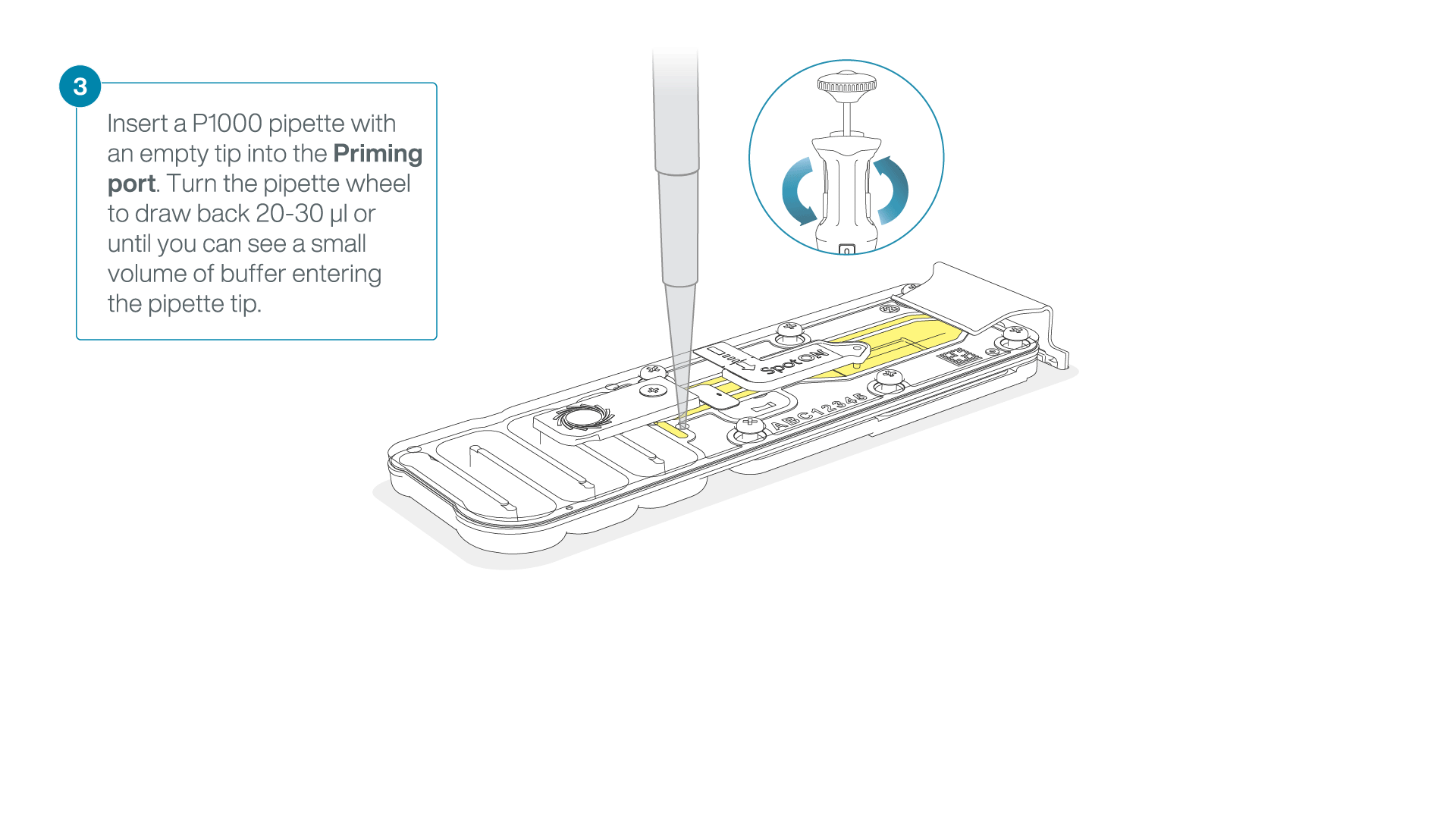
-
Load 800 µl of the priming mix into the flow cell via the priming port, avoiding the introduction of air bubbles. Wait for five minutes. During this time, prepare the library for loading by following the steps below.
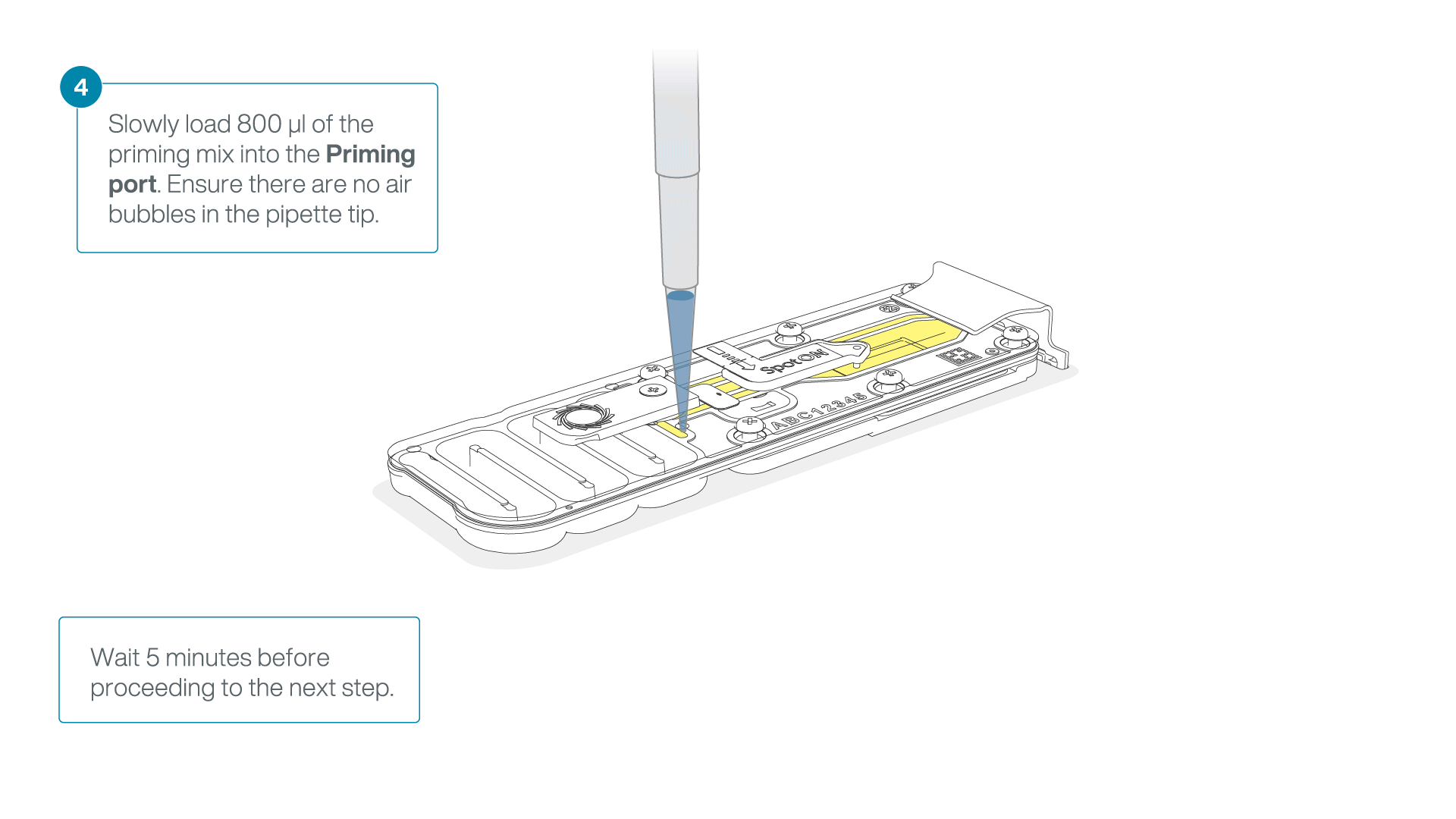
-
Thoroughly mix the contents of the Library Beads (LIB) by pipetting.
-
In a new 1.5 ml Eppendorf DNA LoBind tube, prepare the library for loading as follows:
Reagent Volume per flow cell Sequencing Buffer (SB) 37.5 µl Library Beads (LIB) mixed immediately before use, or Library Solution (LIS), if using 25.5 µl DNA library 12 µl Total 75 µl -
Complete the flow cell priming:
- Gently lift the SpotON sample port cover to make the SpotON sample port accessible.
- Load 200 µl of the priming mix into the flow cell priming port (not the SpotON sample port), avoiding the introduction of air bubbles.
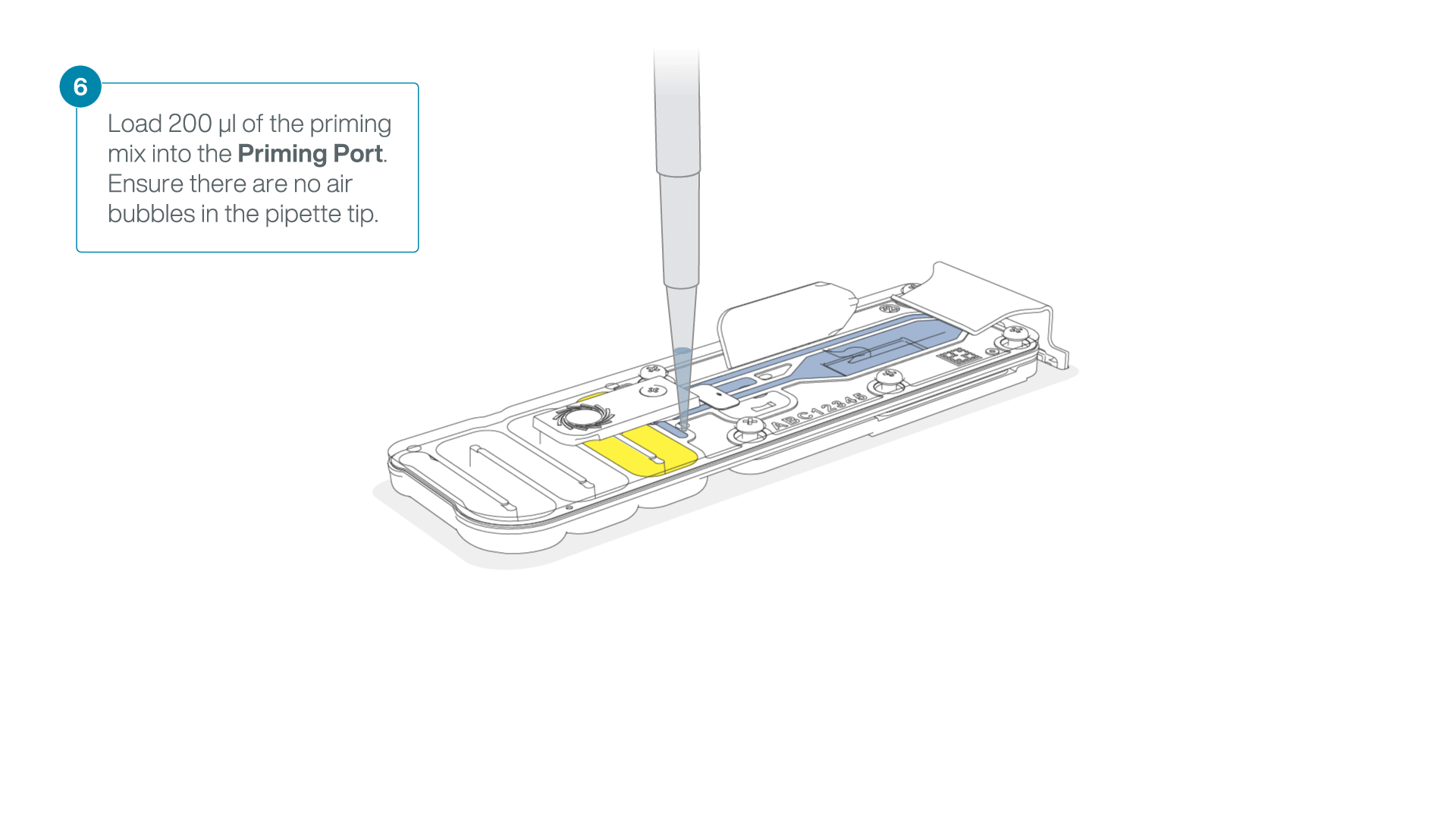
-
Mix the prepared library gently by pipetting up and down just prior to loading.
-
Add 75 μl of the prepared library to the flow cell via the SpotON sample port in a dropwise fashion. Ensure each drop flows into the port before adding the next.

-
Gently replace the SpotON sample port cover, making sure the bung enters the SpotON port and close the priming port.

-
Place the light shield onto the flow cell, as follows:
Carefully place the leading edge of the light shield against the clip.
Note: Do not force the light shield underneath the clip.Gently lower the light shield onto the flow cell. The light shield should sit around the SpotON cover, covering the entire top section of the flow cell.
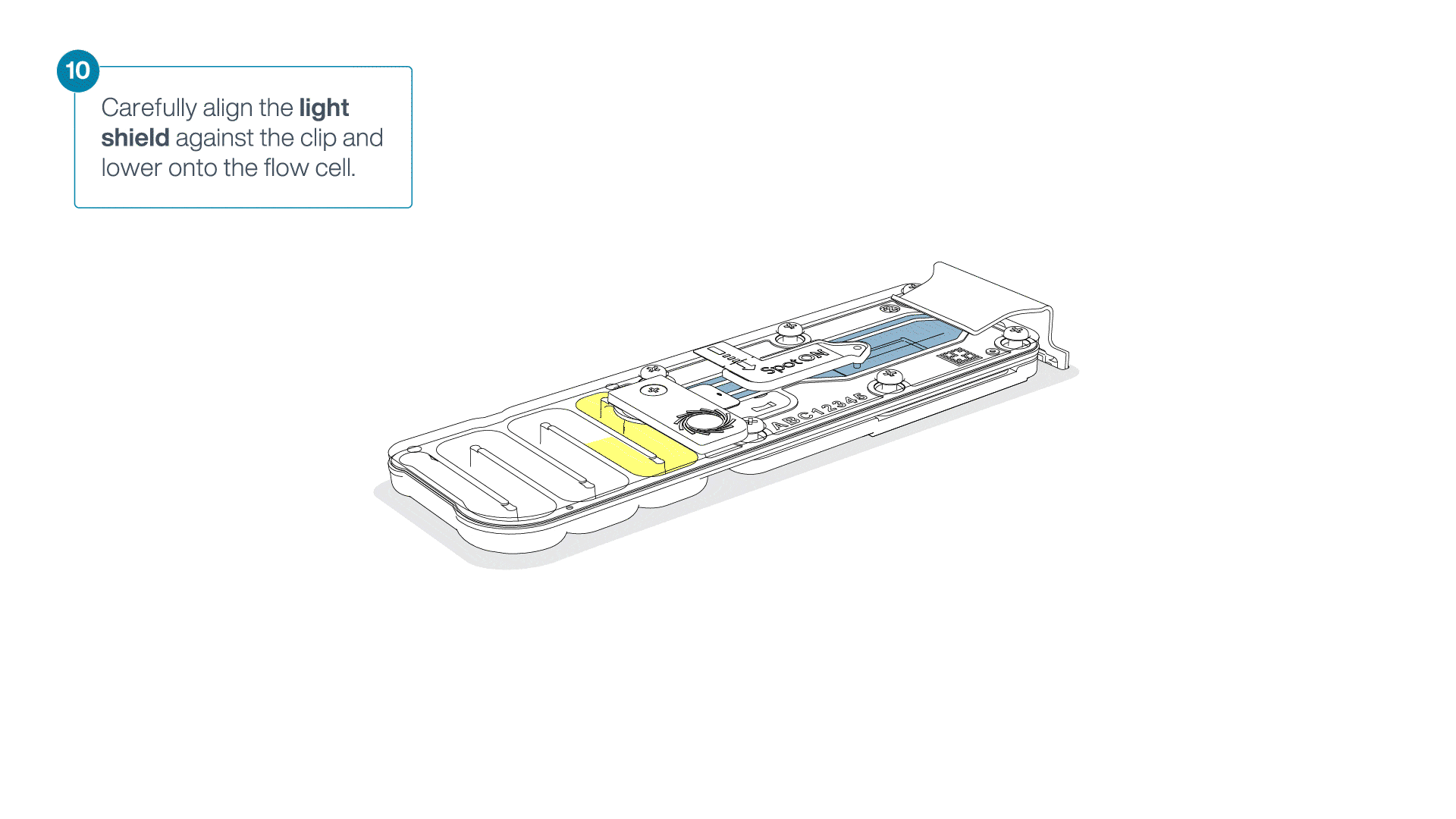
Sequencing and data analysis
Data acquisition and basecalling
Data acquisition and basecalling
-
How to start sequencing
Once you have loaded your flow cell, the sequencing run can be started on MinKNOW, our sequencing software that controls the device, data acquisition and real-time basecalling. For more detailed information on setting up and using MinKNOW, please see the MinKNOW protocol.
MinKNOW can be used and set up to sequence in multiple ways:
- On a computer either direcly or remotely connected to a sequencing device.
- Directly on a GridION or MinION Mk1C sequencing device.
For more information on using MinKNOW on a sequencing device, please see the device user manuals:
- MinION Mk1B user manual
- MinION Mk1C user manual
- MinION Mk1D user manual
- GridION user manual
To start a sequencing run on MinKNOW:
1. Navigate to the start page and click Start sequencing.

2. Fill in your experiment details, such as name and flow cell position and sample ID.
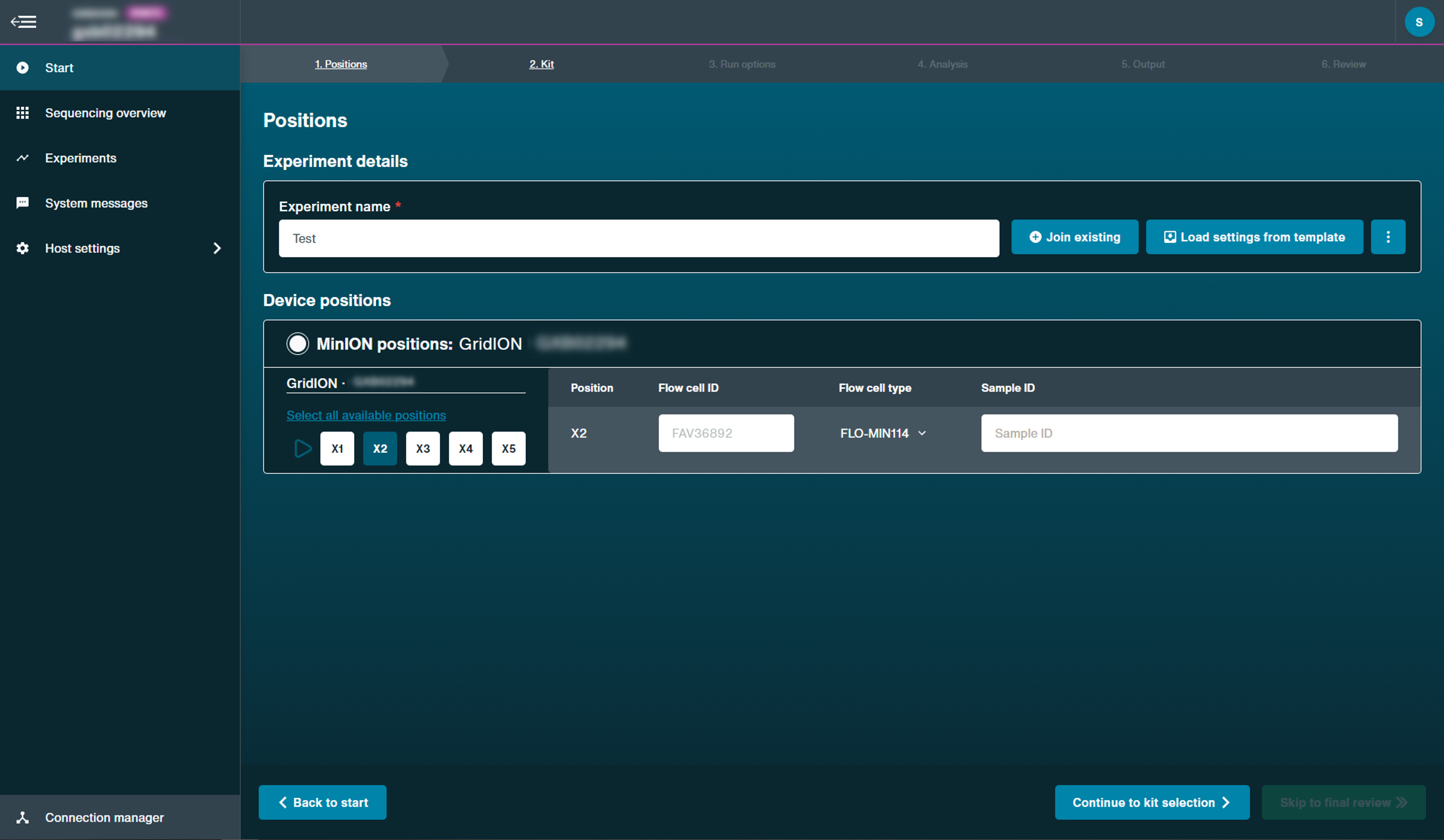
3. Select the Rapid Barcoding Kit 24 V14 (SQK-RBK114.24) or Rapid Barcoding Kit 96 V14 (SQK-RBK114.96).
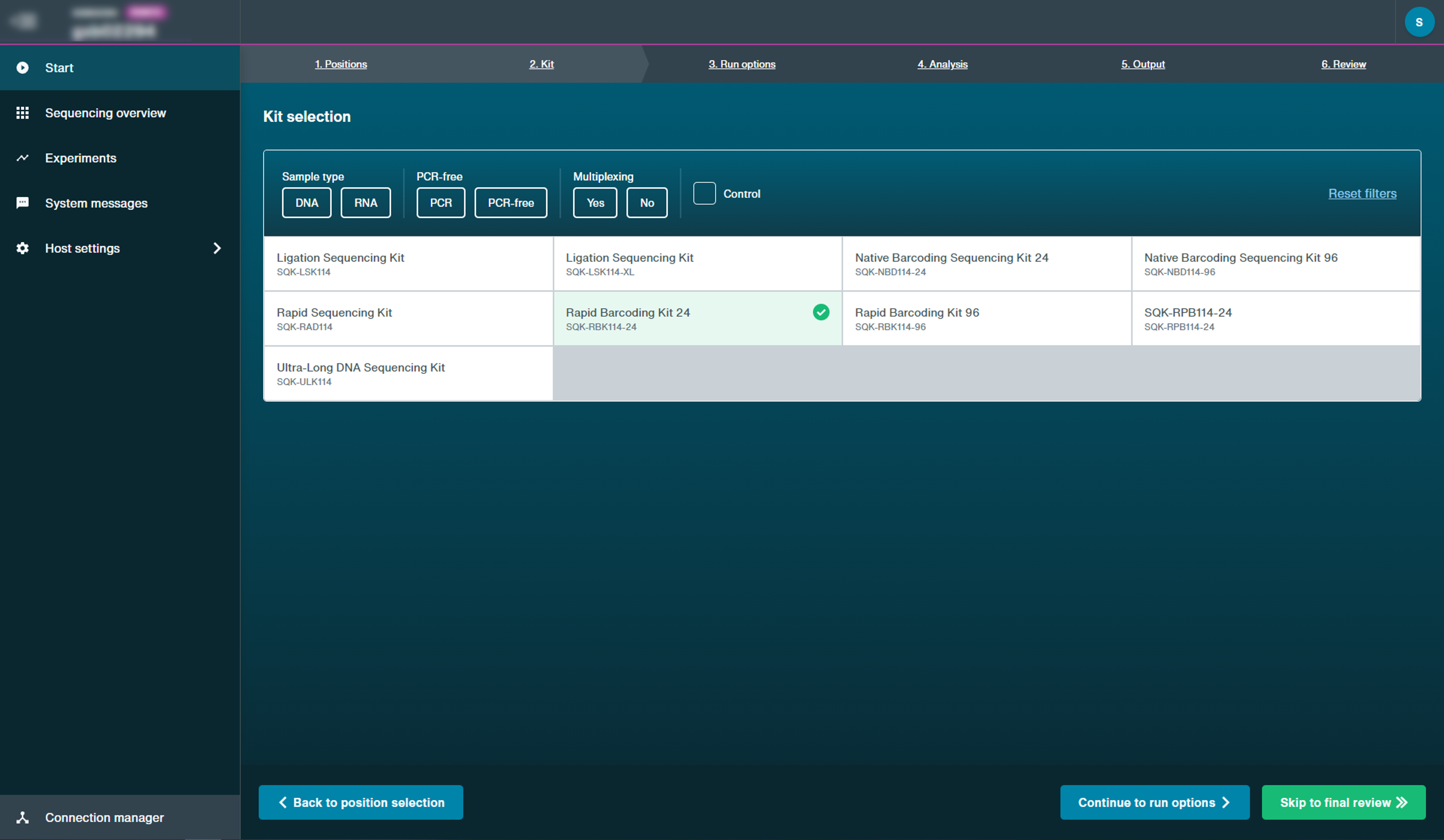
4. Change the run limit to 12 hours by clicking "Options" and changing the run limit value to 12. The other run settings can be left at the defaults.
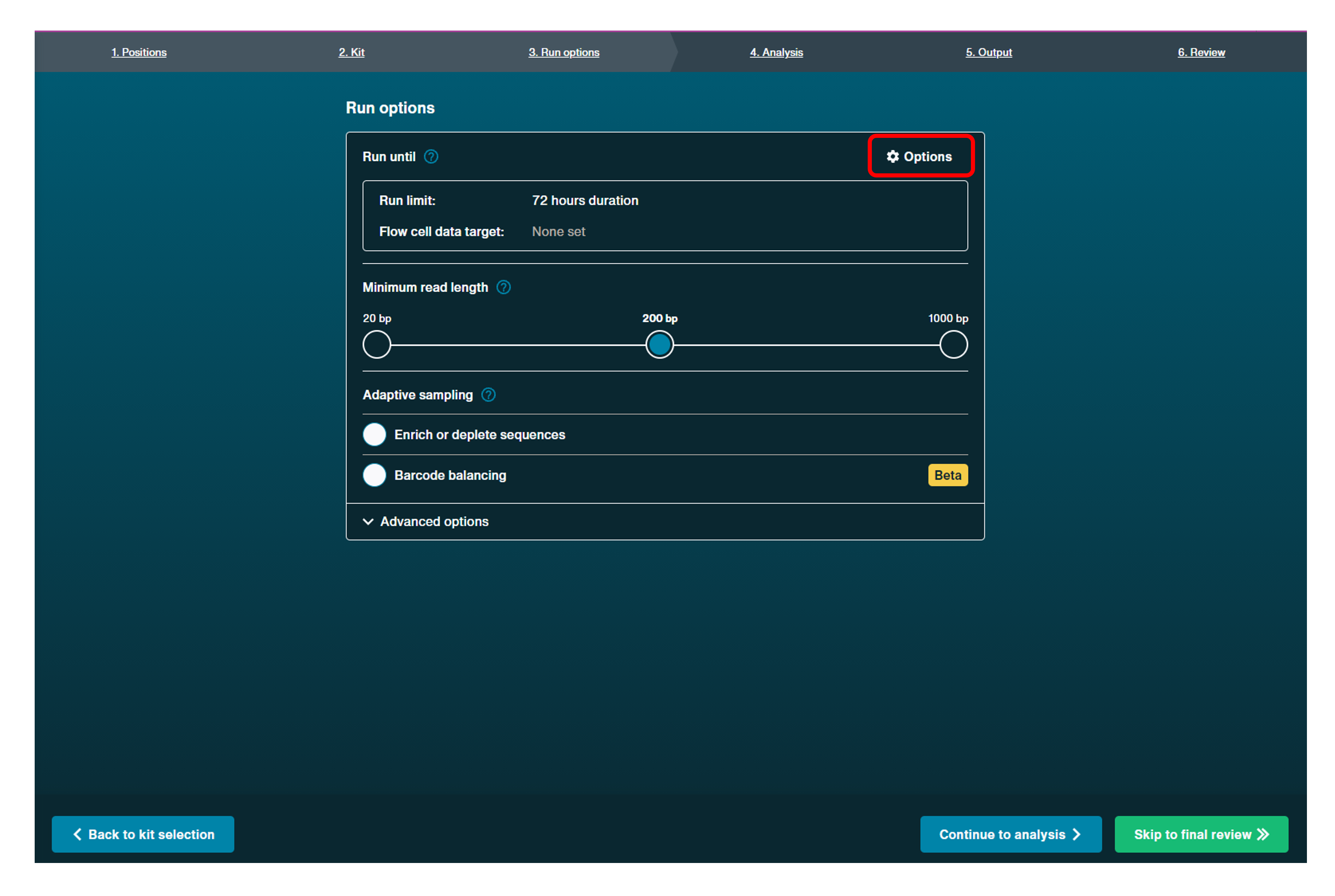
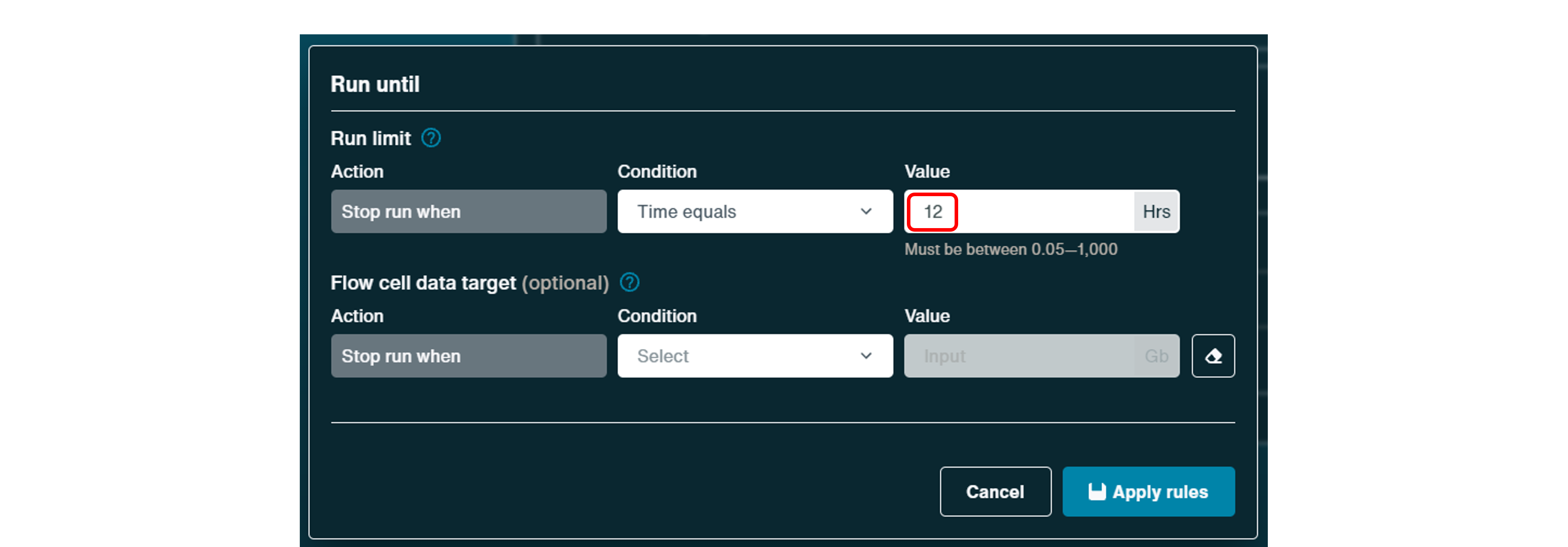
Note: We recommend a run-time of 12 hours for new users to ensure sufficient data is generated for downstream analysis. However, shorter run-times may be sufficient depending on your sample input and analysis requirements.
If using custom sequencing time, for optimal results, we recommend allowing the sequencing run to generate 1000-1500 reads per sample before proceeding to the analysis workflow.5. Set up basecalling and barcoding using the following parameters:
- Toggle basecalling to ON.
- Next to "Models", click Edit options and choose High accuracy basecaller (HAC) from the drop-down menu.
- Toggle barcoding to ON.
- Keep all other options at their default settings.
- Click Continue to output and continue.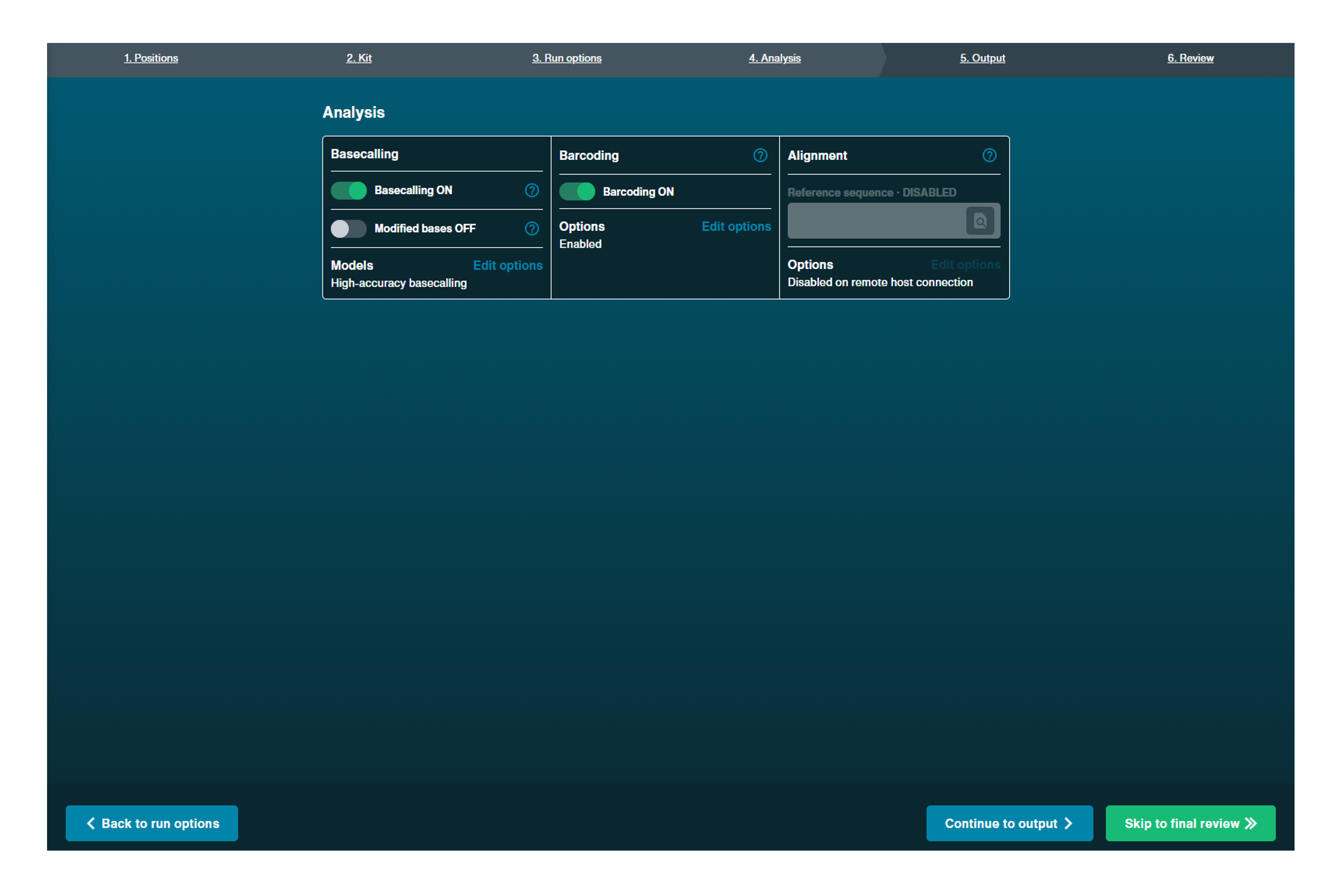
6. Set up the output format and filtering as follows:
- Select either .POD5 or .FAST5 (legacy) as the output format.
- Ensure .FASTQ is selected for basecalled reads.
- Ensure filtering is ON and read splitting is enabled. Other parameters can be kept to their default settings.
- Click Continue to final review to continue.
7. Click Start on the Review page to start the sequencing run.
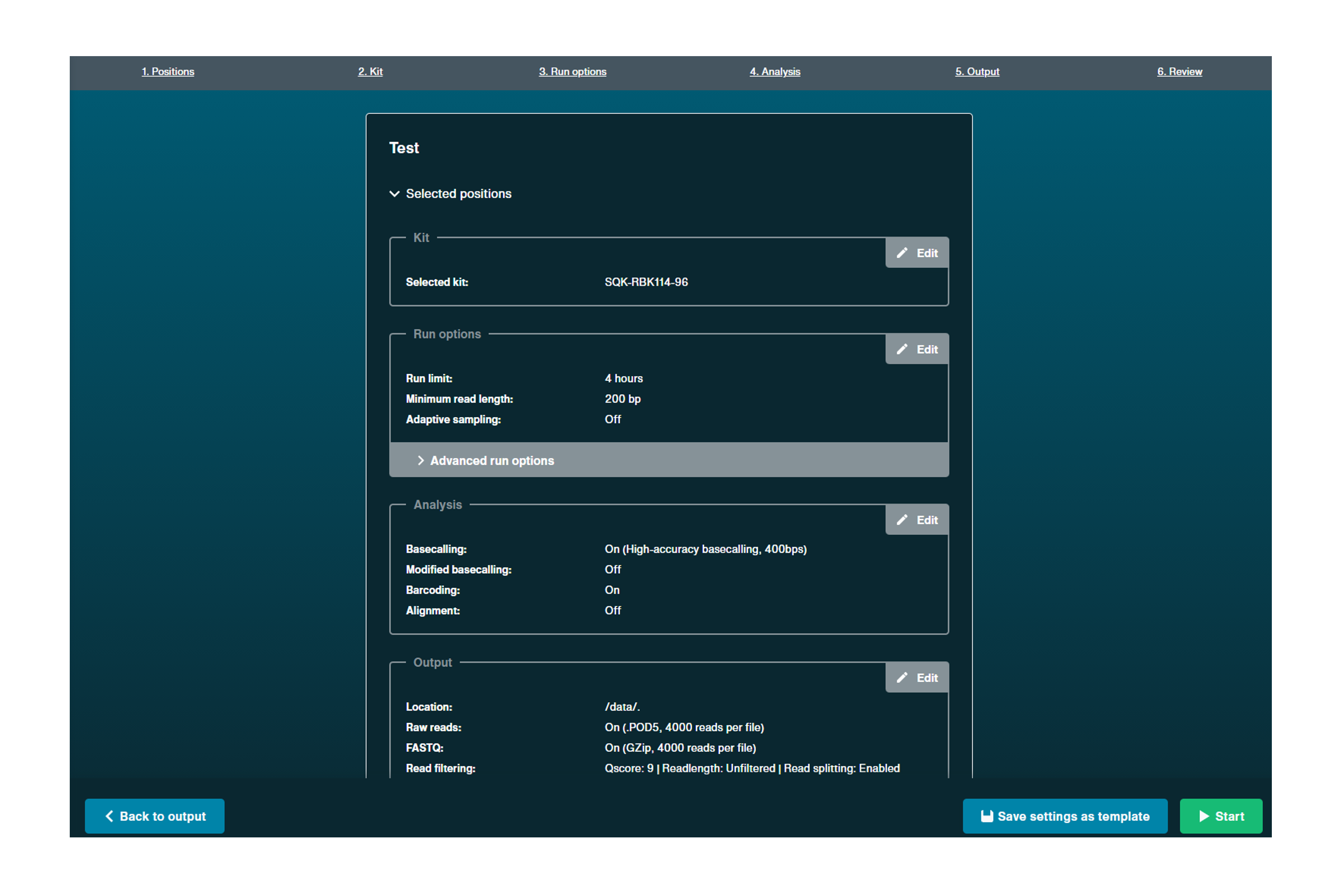
-
Data analysis after sequencing
After sequencing has completed on MinKNOW, the flow cell can be reused or returned, as outlined in the Flow cell reuse and returns section.
After sequencing and basecalling, the data can be analysed. For further information about options for basecalling and post-basecalling analysis, please refer to the Data Analysis document.
In the Downstream analysis section, we outline further options for analysing your data.
Flow cell reuse and returns
Flow cell reuse and returns
- Materials
-
- Flow Cell Wash Kit (EXP-WSH004)
-
After your sequencing experiment is complete, if you would like to reuse the flow cell, please follow the Flow Cell Wash Kit protocol and store the washed flow cell at +2°C to +8°C.
The Flow Cell Wash Kit protocol is available on the Nanopore Community.
-
Alternatively, follow the returns procedure to send the flow cell back to Oxford Nanopore.
Instructions for returning flow cells can be found here.
Downstream analysis using EPI2ME
Downstream analysis using EPI2ME
-
Post-basecalling analysis
We recommend performing downstream analysis using EPI2ME which facilitates bioinformatic analyses by allowing users to run Nextflow workflows in a desktop application. EPI2ME maintains a collection of bioinformatic workflows which are curated and actively maintained by experts in long-read sequence analysis.
Further information about the available EPI2ME workflows can be found here, along with the Quick Start Guide to start your first bioinformatic workflow.
For the analysis of amplicon sequences, we recommend using the wf-amplicon workflow which requires Nextflow and Docker or Singularity to be installed before running the workflow.
For installation instructions please click here.
-
Open the EPI2ME app using the desktop shortcut.
-
Click on "Run this workflow" to open the launch wizard.
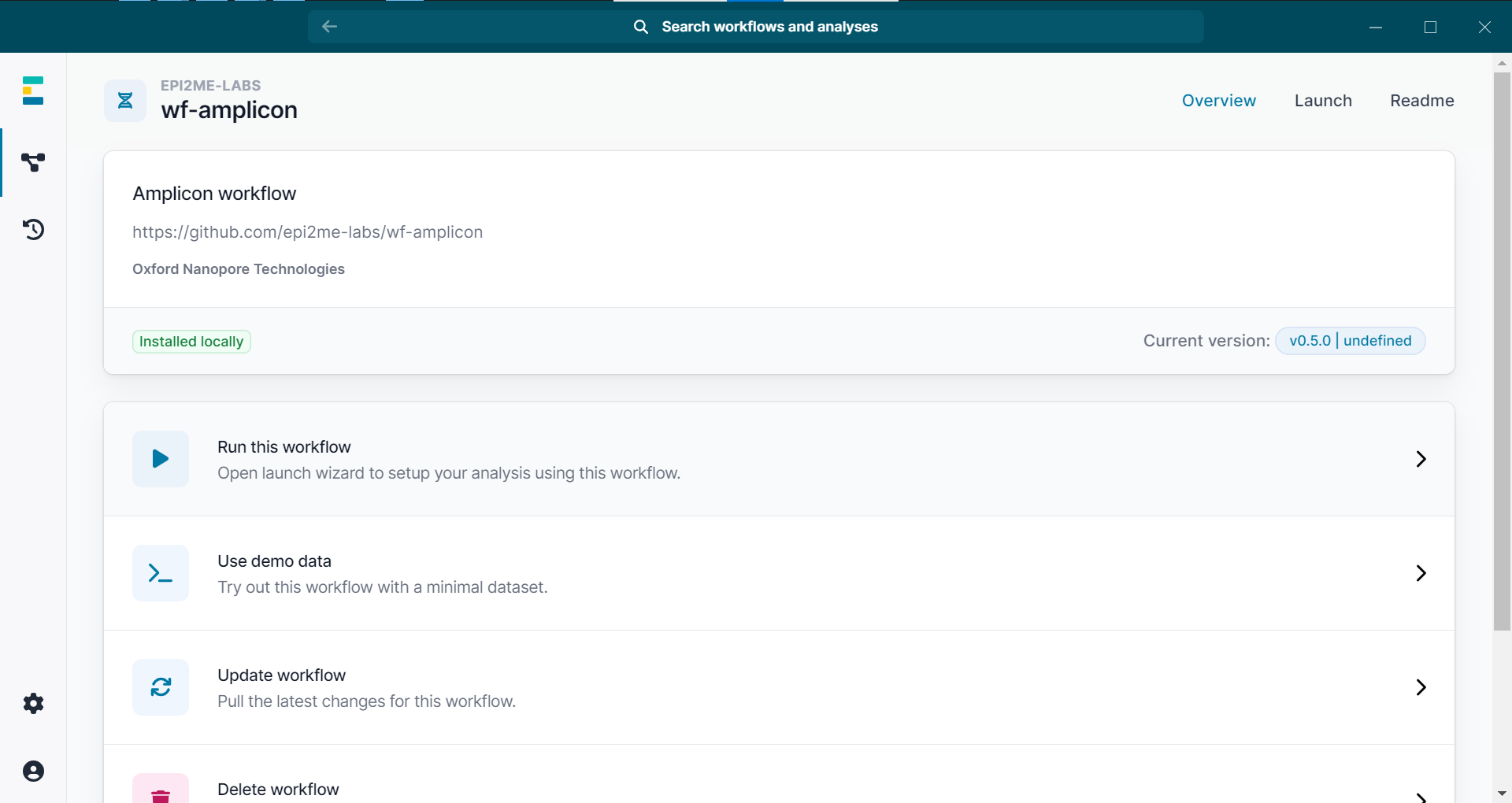
-
Set up your run by selecting your sequencing data in the "Input Options".
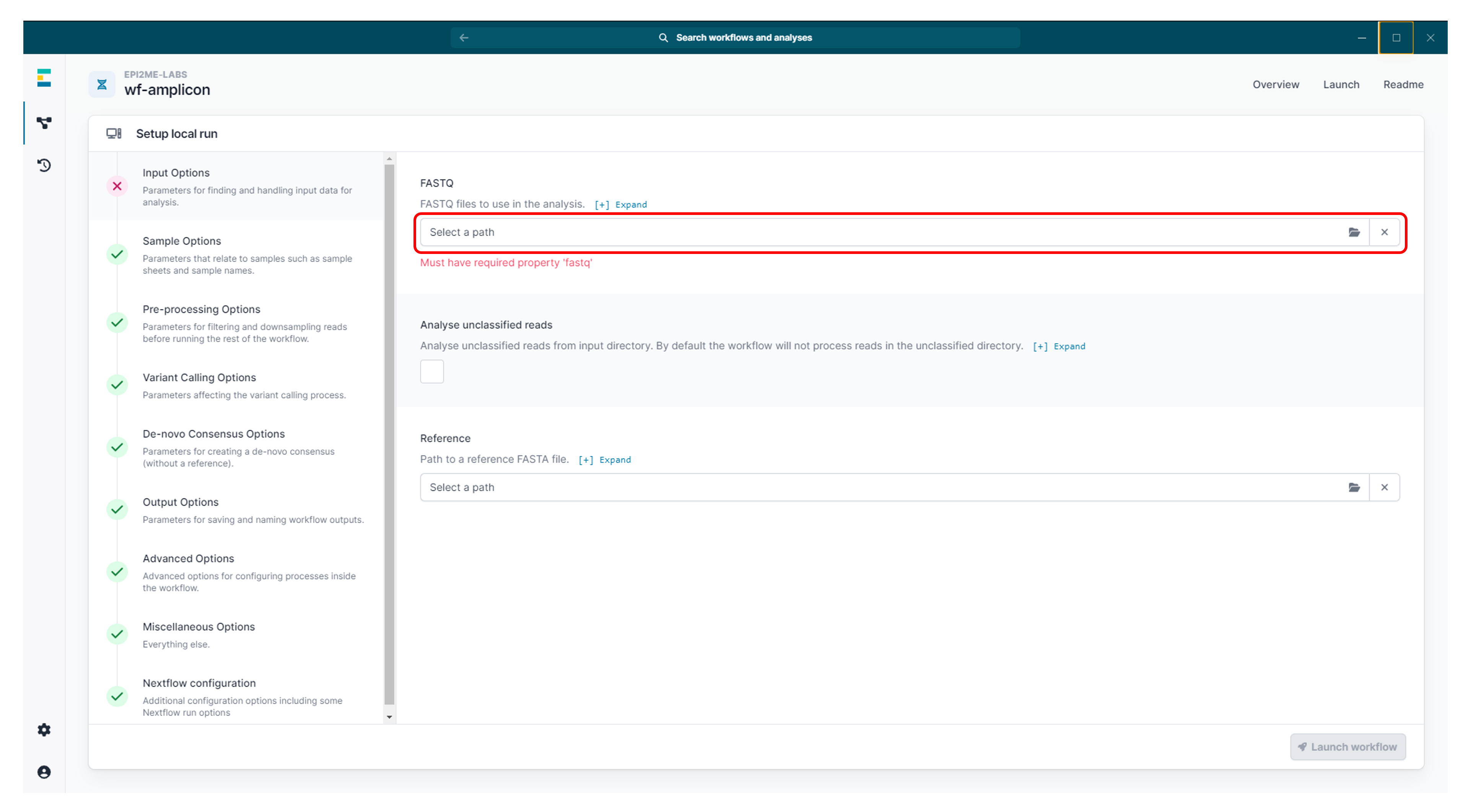
-
To speed up the analysis, you can set "Downsampling size" to 500.
Unless your amplicons are very long (>5 kb), this should provide sufficient coverage.
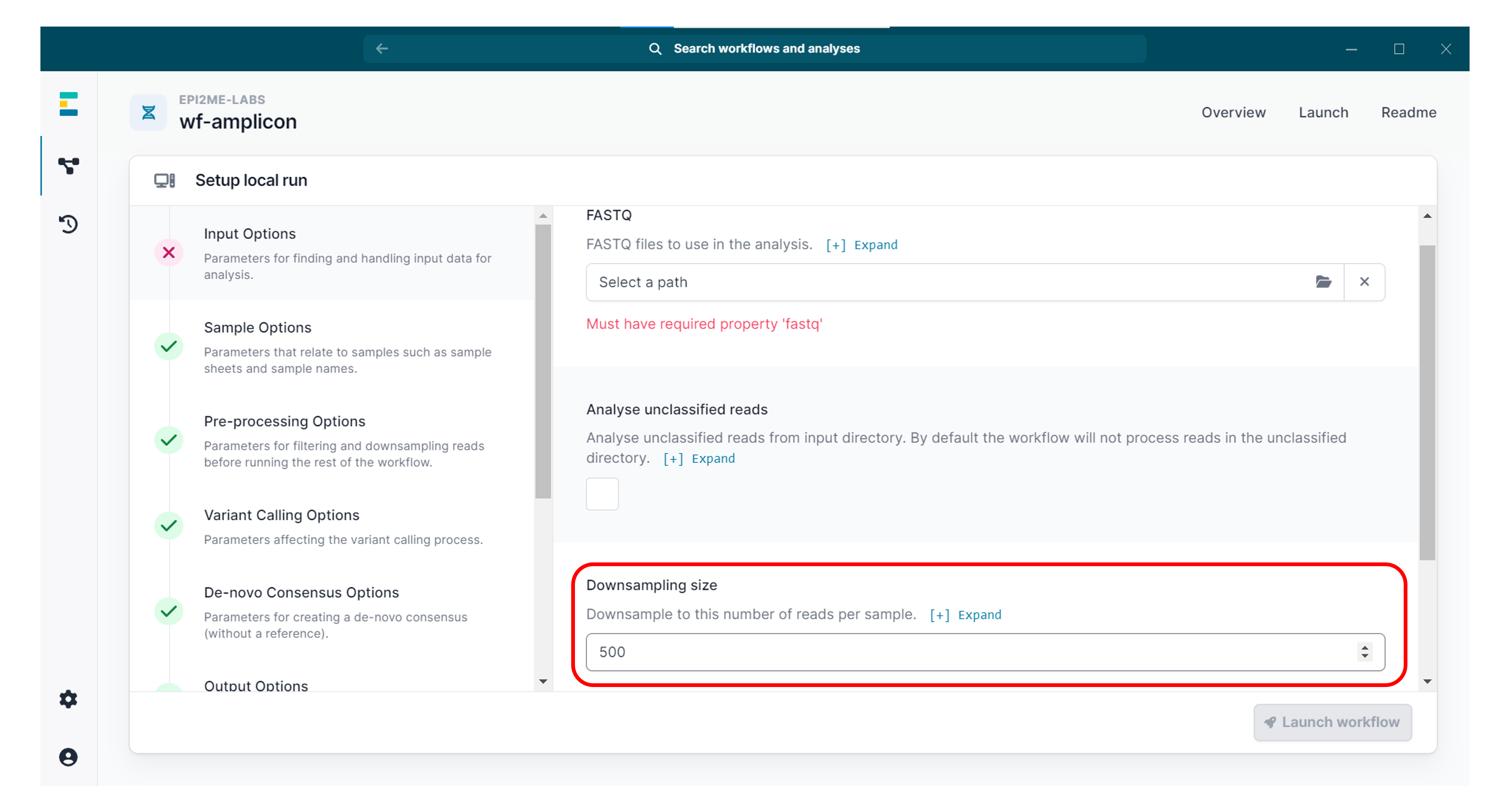
-
Optional ActionThe amplicon workflow can be run with a sequence reference file if required.
Set up the reference FASTA by uploading the file in the following location:

-
For the remaining parameter options we recommend keeping the default settings.
-
Click "Launch workflow".
Ensure all parameter options have green ticks.
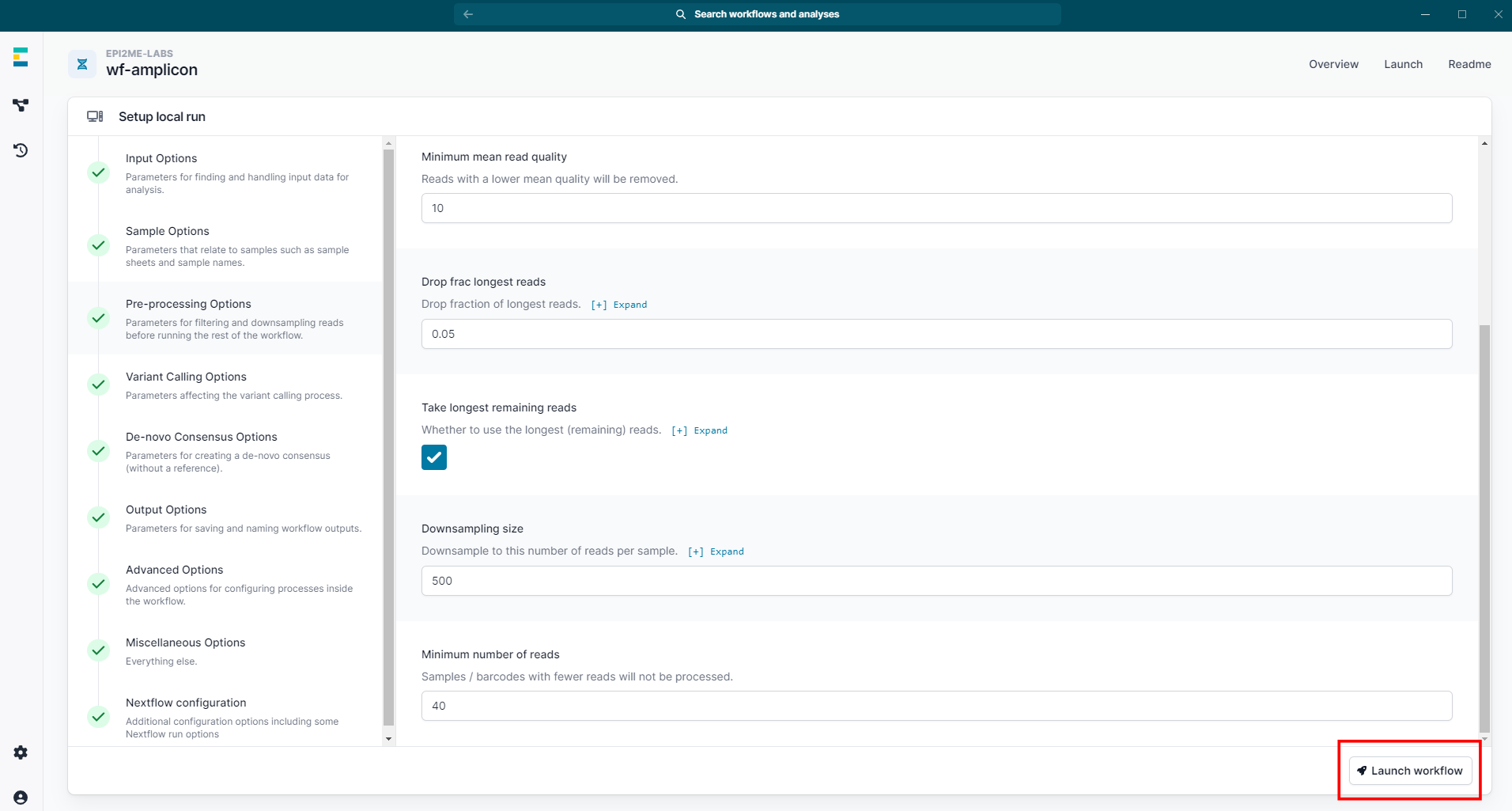
-
Once the workflow finishes, a report will be produced.
-
Amplicon workflow report
The primary outputs of the workflow include:
· an interactive HTML report with tables and plots detailing the results.
· FASTQ files (one per barcode) with the de-novo consensus sequence and per-base consensus qualities (as calculated by Medaka).
· BAM files (one per barcode) of input reads re-aligned against the consensus.Example reports:
· When a reference file has been uploaded, reads are aligned to the reference (containing the expected sequence for each amplicon) for variant calling. An example of a sample variant calling report can be viewed here.
· When no reference file has been uploaded, the amplicon’s consensus sequence is generated de novo. An example of sample de novo consensus report can be viewed here.Report contents
The report consists of several sections. The introduction section gives a brief overview of key results for the individual samples analysed, while the preprocessing section illustrates the number of reads removed during downsampling / filtering. It also contains read length and quality histograms as well as a plot showing base yield vs. read length.
The remaining sections of the report depend on the mode in which the workflow was run. In variant calling mode, they summarise the mapping and variant calling stages of the workflow, showing the depth of coverage of aligned reads and providing further details on the variants called. In de novo consensus mode, results of the draft consensus QC stage and re-alignment of input reads against the consensus are described. Additionally, a depth of coverage plot of the re-aligned reads along the consensus is shown.
Troubleshooting
Issues during DNA/RNA extraction and library preparation
Issues during DNA/RNA extraction and library preparation
-
Below is a list of the most commonly encountered issues, with some suggested causes and solutions.
We also have an FAQ section available on the Nanopore Community Support section.
If you have tried our suggested solutions and the issue still persists, please contact Technical Support via email (support@nanoporetech.com) or via LiveChat in the Nanopore Community.
-
Low sample quality
Observation Possible cause Comments and actions Low DNA purity (Nanodrop reading for DNA OD 260/280 is <1.8 and OD 260/230 is <2.0–2.2) The DNA extraction method does not provide the required purity The effects of contaminants are shown in the Contaminants document. Please try an alternative extraction method that does not result in contaminant carryover.
Consider performing an additional SPRI clean-up step.Low RNA integrity (RNA integrity number <9.5 RIN, or the rRNA band is shown as a smear on the gel) The RNA degraded during extraction Try a different RNA extraction method. For more info on RIN, please see the RNA Integrity Number document. Further information can be found in the DNA/RNA Handling page. RNA has a shorter than expected fragment length The RNA degraded during extraction Try a different RNA extraction method. For more info on RIN, please see the RNA Integrity Number document. Further information can be found in the DNA/RNA Handling page.
We recommend working in an RNase-free environment, and to keep your lab equipment RNase-free when working with RNA. -
Low DNA recovery after AMPure bead clean-up
Observation Possible cause Comments and actions Low recovery DNA loss due to a lower than intended AMPure beads-to-sample ratio 1. AMPure beads settle quickly, so ensure they are well resuspended before adding them to the sample.
2. When the AMPure beads-to-sample ratio is lower than 0.4:1, DNA fragments of any size will be lost during the clean-up.Low recovery DNA fragments are shorter than expected The lower the AMPure beads-to-sample ratio, the more stringent the selection against short fragments. Please always determine the input DNA length on an agarose gel (or other gel electrophoresis methods) and then calculate the appropriate amount of AMPure beads to use. 
Low recovery after end-prep The wash step used ethanol <70% DNA will be eluted from the beads when using ethanol <70%. Make sure to use the correct percentage. -
The VolTRAX run terminated in the middle of the library prep
Observation Possible cause Comments and actions The green light was switched off
or
An adapter was used to connect the VolTRAX USB-C cable to the computerInsufficient power supply to the VolTRAX The green LED signals that 3 A are being supplied to the device. This is the requirement for the full capabilities of the VolTRAX V2 device. Please use computers that meet the requirements listed on the VolTRAX V2 protocol. -
The VolTRAX software shows an inaccurate amount of reagents loaded
Observation Possible cause Comments and actions The VolTRAX software shows an inaccurate amount of reagents loaded Pipette tips do not fit the VolTRAX cartridge ports Rainin 20 μl or 30 μl and Gilson 10 μl, 20 μl or 30 μl pipette tips are compatible with loading reagents into the VolTRAX cartridge. Rainin 20 μl is the most suitable. The VolTRAX software shows an inaccurate amount of reagents loaded The angle at which reagents are pipetted into the cartridge is incorrect The pipetting angle should be slightly greater than the cartridge inlet angle. Please watch the demo video included in the VolTRAX software before loading.
Issues during the sequencing run
Issues during the sequencing run
-
Below is a list of the most commonly encountered issues, with some suggested causes and solutions.
We also have an FAQ section available on the Nanopore Community Support section.
If you have tried our suggested solutions and the issue still persists, please contact Technical Support via email (support@nanoporetech.com) or via LiveChat in the Nanopore Community.
-
Fewer pores at the start of sequencing than after Flow Cell Check
Observation Possible cause Comments and actions MinKNOW reported a lower number of pores at the start of sequencing than the number reported by the Flow Cell Check An air bubble was introduced into the nanopore array After the Flow Cell Check it is essential to remove any air bubbles near the priming port before priming the flow cell. If not removed, the air bubble can travel to the nanopore array and irreversibly damage the nanopores that have been exposed to air. The best practice to prevent this from happening is demonstrated in this video. MinKNOW reported a lower number of pores at the start of sequencing than the number reported by the Flow Cell Check The flow cell is not correctly inserted into the device Stop the sequencing run, remove the flow cell from the sequencing device and insert it again, checking that the flow cell is firmly seated in the device and that it has reached the target temperature. If applicable, try a different position on the device (GridION/PromethION). MinKNOW reported a lower number of pores at the start of sequencing than the number reported by the Flow Cell Check Contaminations in the library damaged or blocked the pores The pore count during the Flow Cell Check is performed using the QC DNA molecules present in the flow cell storage buffer. At the start of sequencing, the library itself is used to estimate the number of active pores. Because of this, variability of about 10% in the number of pores is expected. A significantly lower pore count reported at the start of sequencing can be due to contaminants in the library that have damaged the membranes or blocked the pores. Alternative DNA/RNA extraction or purification methods may be needed to improve the purity of the input material. The effects of contaminants are shown in the Contaminants Know-how piece. Please try an alternative extraction method that does not result in contaminant carryover. -
MinKNOW script failed
Observation Possible cause Comments and actions MinKNOW shows "Script failed" Restart the computer and then restart MinKNOW. If the issue persists, please collect the MinKNOW log files and contact Technical Support. If you do not have another sequencing device available, we recommend storing the flow cell and the loaded library at 4°C and contact Technical Support for further storage guidance. -
Pore occupancy below 40%
Observation Possible cause Comments and actions Pore occupancy <40% Not enough library was loaded on the flow cell Ensure you load the recommended amount of good quality library in the relevant library prep protocol onto your flow cell. Please quantify the library before loading and calculate mols using tools like the Promega Biomath Calculator, choosing "dsDNA: µg to pmol" Pore occupancy close to 0 The Ligation Sequencing Kit was used, and sequencing adapters did not ligate to the DNA Make sure to use the NEBNext Quick Ligation Module (E6056) and Oxford Nanopore Technologies Ligation Buffer (LNB, provided in the sequencing kit) at the sequencing adapter ligation step, and use the correct amount of each reagent. A Lambda control library can be prepared to test the integrity of the third-party reagents. Pore occupancy close to 0 The Ligation Sequencing Kit was used, and ethanol was used instead of LFB or SFB at the wash step after sequencing adapter ligation Ethanol can denature the motor protein on the sequencing adapters. Make sure the LFB or SFB buffer was used after ligation of sequencing adapters. Pore occupancy close to 0 No tether on the flow cell Tethers are adding during flow cell priming (FLT/FCT tube). Make sure FLT/FCT was added to FB/FCF before priming. -
Shorter than expected read length
Observation Possible cause Comments and actions Shorter than expected read length Unwanted fragmentation of DNA sample Read length reflects input DNA fragment length. Input DNA can be fragmented during extraction and library prep.
1. Please review the Extraction Methods in the Nanopore Community for best practice for extraction.
2. Visualise the input DNA fragment length distribution on an agarose gel before proceeding to the library prep.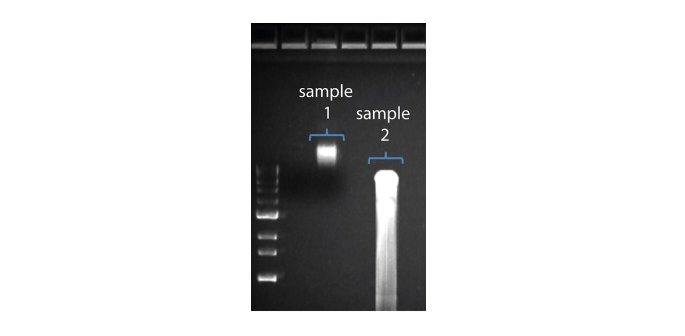 In the image above, Sample 1 is of high molecular weight, whereas Sample 2 has been fragmented.
In the image above, Sample 1 is of high molecular weight, whereas Sample 2 has been fragmented.
3. During library prep, avoid pipetting and vortexing when mixing reagents. Flicking or inverting the tube is sufficient. -
Large proportion of inactive pores
Observation Possible cause Comments and actions Large proportion of inactive/unavailable pores (shown as light blue in the channels panel and pore activity plot. Pores or membranes are irreversibly damaged) Air bubbles have been introduced into the flow cell Air bubbles introduced through flow cell priming and library loading can irreversibly damage the pores. Watch the Priming and loading your flow cell video for best practice Large proportion of inactive/unavailable pores Certain compounds co-purified with DNA Known compounds, include polysaccharides, typically associate with plant genomic DNA.
1. Please refer to the Plant leaf DNA extraction method.
2. Clean-up using the QIAGEN PowerClean Pro kit.
3. Perform a whole genome amplification with the original gDNA sample using the QIAGEN REPLI-g kit.Large proportion of inactive/unavailable pores Contaminants are present in the sample The effects of contaminants are shown in the Contaminants Know-how piece. Please try an alternative extraction method that does not result in contaminant carryover. -
Reduction in sequencing speed and q-score later into the run
Observation Possible cause Comments and actions Reduction in sequencing speed and q-score later into the run For Kit 9 chemistry (e.g. SQK-LSK109), fast fuel consumption is typically seen when the flow cell is overloaded with library (please see the appropriate protocol for your DNA library to see the recommendation). Add more fuel to the flow cell by following the instructions in the MinKNOW protocol. In future experiments, load lower amounts of library to the flow cell. -
Temperature fluctuation
Observation Possible cause Comments and actions Temperature fluctuation The flow cell has lost contact with the device Check that there is a heat pad covering the metal plate on the back of the flow cell. Re-insert the flow cell and press it down to make sure the connector pins are firmly in contact with the device. If the problem persists, please contact Technical Services. -
Failed to reach target temperature
Observation Possible cause Comments and actions MinKNOW shows "Failed to reach target temperature" The instrument was placed in a location that is colder than normal room temperature, or a location with poor ventilation (which leads to the flow cells overheating) MinKNOW has a default timeframe for the flow cell to reach the target temperature. Once the timeframe is exceeded, an error message will appear and the sequencing experiment will continue. However, sequencing at an incorrect temperature may lead to a decrease in throughput and lower q-scores. Please adjust the location of the sequencing device to ensure that it is placed at room temperature with good ventilation, then re-start the process in MinKNOW. Please refer to this link for more information on MinION temperature control.
Become a full member
Purchase a MinION Starter Pack from Avantor to get full community access and benefit from:
- News - hear about the latest product updates
- Posts - interact with thousands of nanopore users from around the globe
- Software - download the latest sequencing and analysis software
Already have a Nanopore Community account?
Log in hereNeed more help?
Request a call with our experts for detailed advice on implementing nanopore sequencing.
Request a callInterested in microbiology?
Visit our microbial sequencing spotlight page on vwr.com.
Microbial sequencing

















 In the image above, Sample 1 is of high molecular weight, whereas Sample 2 has been fragmented.
In the image above, Sample 1 is of high molecular weight, whereas Sample 2 has been fragmented. The pore activity plot above shows an increasing proportion of "unavailable" pores over time.
The pore activity plot above shows an increasing proportion of "unavailable" pores over time.